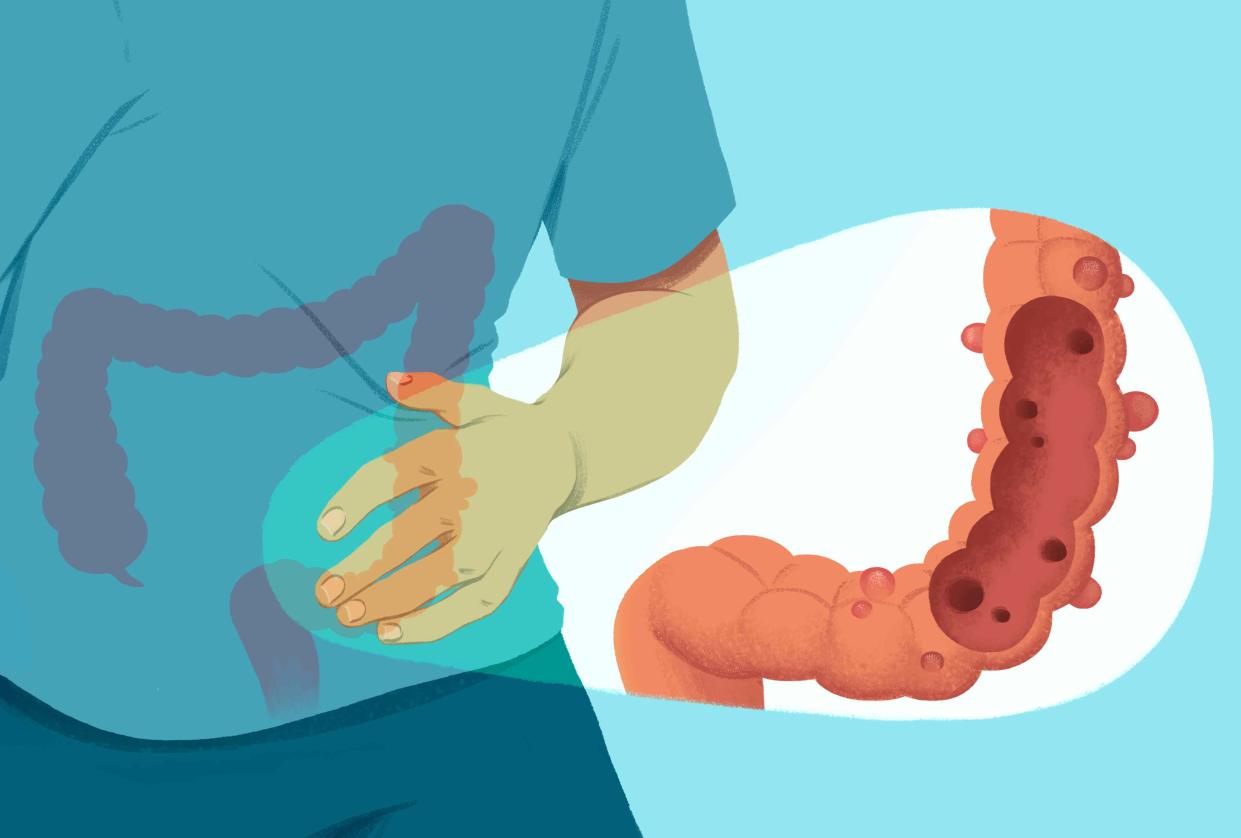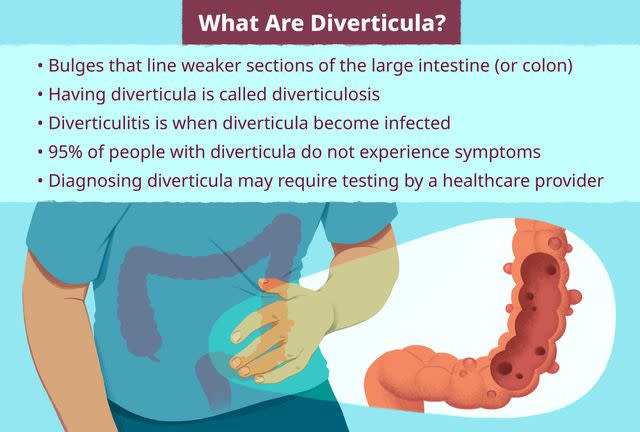What Are Diverticula?

Illustration by Mira Norian for Verywell Health
Medically reviewed by Jay N. Yepuri, MD, MS
Diverticula are bulges in the lining of the wall of the intestinal tract. They can occur anywhere that the lining of the intestinal tract weakens. They usually occur in the sigmoid colon, the lower part of the colon.
The intestines are long, tubular organs that begin past the stomach and are where food passes through before exiting the body. The large intestine, or colon, is just past the small intestine, and both are part of the gastrointestinal tract tract.

Illustration by Mira Norian for Verywell Health
The condition of having diverticula is called diverticulosis. Diverticulitis, on the other hand, is when diverticula become infected. Both diverticula and diverticulitis can be labeled diverticular disease.
About half of adults aged 60 or older live with diverticula. Most people with diverticula do not experience symptoms or complications.
What Is the Main Cause of Diverticula?
The exact cause of diverticula has not yet been discovered, but some possibilities include:
Not eating enough dietary fiber: Fiber helps with digestion by softening stools and preventing constipation. Constipation and hard stools can increase pressure against intestinal walls.
Low healthy gut bacteria: Healthy gut bacteria support digestion while keeping intestinal walls functioning efficiently. Sources of healthy bacteria (also called probiotics) include yogurt and other fermented foods.
High unhealthy bacteria in the colon: Unhealthy bacteria in the colon can cause inflammation (the body's reaction to invaders), which can increase gas and constipation.
Lack of exercise: Exercise can help digestion and might reduce the risk of diverticula.
Medications: Nonsteroidal anti-inflammatory drugs (NSAIDs) like ibuprofen and steroids can affect the structure of intestinal walls.
Smoking: Smoking can increase the chance of developing diverticulitis by 140%. This might be because smoking can weaken the muscular strength of intestinal walls, which affects digestion. Smoking can also be associated with lack of exercise or a low-fiber diet.
Genetics: Since disorders of the body's muscles can be inherited, having a parent with a history of diverticula might increase the chances of having them yourself. Social factors, like diet and environment, can also account for what seems like a genetic component.
Diverticula are not likely to disappear, however, 95% of people with diverticula do not experience symptoms. However, 1 in 5 people with diverticulitis could experience complications. Diverticulitis is a lifelong condition, but it can be managed via a high-fiber diet and a healthy lifestyle.
If severe diverticulitis symptoms occur more than twice, surgery to remove parts of the lower intestine (colon) might be required.
How Do You Know If You Have Diverticula?
Diverticula are common among older adults, many of whom do not experience symptoms. If symptoms occur, they can indicate diverticulitis. Symptoms of diverticulitis might include:
Intense stomach pain that can happen over time or suddenly
Constipation and/or diarrhea
Cramps and bloating
Stomach pain with vomiting, fever, constipation, or diarrhea
Large amounts of blood in stools
Blood in the rectum
To diagnose diverticula, a healthcare provider might request one or more of the following tests:
CT (computed tomography) scan: A series of detailed X-rays of the colon
Barium enema/lower GI series: Injecting barium into the colon so it is more visible under X-ray
Flexible sigmoidoscopy: Using a thin tube with a camera attached that's inserted into the rectum
Colonoscopy: Using a thin tube with a camera attached to view the colon
Diverticula can be common among older adults. However, if symptoms occur, they might indicate damage to the intestinal walls. Treating diverticulitis can usually be done at home with:
Increased fiber intake
Tylenol (acetaminophen) for pain management (avoid NSAIDs, like ibuprofen, as they can irritate the stomach)
Bulk-forming laxatives with plenty of water (ask a healthcare professional which laxatives are best)
Blood transfusion, in cases of extreme bleeding, whose symptoms include feeling faint, having clammy skin, and having difficulty breathing
In extreme cases and when at-home treatments fail to work in a couple of days, diverticulitis treatment can require:
Antibiotics with hydration: Given via intravenous (IV) injection
Surgical removal of diverticula if having had at least two episodes of diverticulitis or diverticulitis since childhood
Colectomy: Removing the part of the large intestine that is affected
Stoma surgery: Attaching a bag to the abdominal wall to divert stool flow from part of the large intestine while it heals (or permanently, in extreme cases)
Diverticula cause no symptoms in 95% of people who have them, however, among people with diverticulitis, 1 in 5 can experience complications. The outlook in patients past the first 100 days of treatment for diverticulitis is that 95% are likely to live at least five more years and 91%are likely to live at least a decade longer. Since most people with diverticula are older, age is a factor in life expectancy after treatment.
Diverticula vs. Diverticulum
Diverticula are multiple pouches or bulges pushing through weaker parts of the colon's lining. The word "diverticulum" refers to a single pouch or bulge.
Diverticulitis
Diverticula can become inflamed (swollen or infected). Inflammation is the body's response to injury. Inflammation of the diverticula can cause diverticulitis. Only about 5% of people who have diverticula experience diverticulitis.
Complications of diverticulitis can be highly dangerous, so it's advised to seek treatment as soon as possible. These complications can include:
Bleeding
Pain while urinating or needing to urinate more often
Abscess: A pus-filled lump in the colon that requires draining by a healthcare provider
Fistula: Damaged tissues can attach and create fistula, or tubes that connect tissues together
Peritonitis: An infection of the stomach's lining
Perforation: Hole in the intestinal wall
Intestinal obstruction: Scarring of the intestines, which can cause blockages that prevent food, liquid, stools, and air from moving through intestines
Coping With Diverticula
A healthy lifestyle can help with staying healthy while living with diverticula. This includes:
Eating a high-fiber diet containing plenty of fruits and vegetables
Getting regular exercise
Staying hydrating
Following your healthcare provider's advice regarding avoiding foods that can worsen diverticulitis
Notifying a healthcare professional as soon as you experience symptoms, so that dangerous complications (like intestinal blockages) are avoided
Summary
Diverticula are bulges in the lining of the intestines. They most commonly occur in the large intestine (colon). They are common in about half of the older adult (over age 60) population. Diverticula might be caused by a low-fiber diet, lack of exercise, lack of beneficial bacteria in the gut or a high amount of unhealthy bacteria in the colon, smoking, genetics, or obesity.
Most people do not experience symptoms of diverticula. Symptoms of diverticulitis, or inflammation of diverticula, might include extreme stomach pain, blood in stools, cramps, bloating, diarrhea, or constipation.

